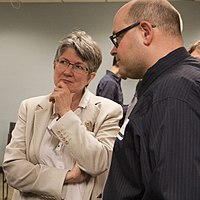
Photo from wikipedia
Research with refugees, internally displaced persons (IDPs) and other marginalized groups entails complexities that make it imperative to think through the ethical and methodological strategies to not only ‘do no… Click to show full abstract
Research with refugees, internally displaced persons (IDPs) and other marginalized groups entails complexities that make it imperative to think through the ethical and methodological strategies to not only ‘do no harm’, but also allow the research to be valuable for the participants. This article contributes to this methodological debate by demonstrating how participatory visual research offers an innovative tool for democratizing research and avoiding the risk of retraumatization. This type of research moreover enables participants to visually represent and communicate their—gender-specific—truth, thus enabling them to counter official representations of their situation and gendered stereotypes of vulnerable IDP women. Participatory visual research can thus become an instrument to contribute to social change, in line with the goals of feminist research. This article describes its use during a research process with women in two communities of returned IDPs in Colombia’s Caribbean coast.
Journal Title: Journal of Refugee Studies
Year Published: 2018
Link to full text (if available)
Share on Social Media: Sign Up to like & get
recommendations!